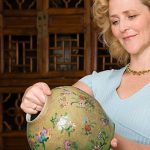 The holiday season is coming to a close and your children have probably unwrapped all their presents, although you’re probably still dreaming about all of them. Maybe you have been thinking back to all of the Christmases of your childhood and the toys you received. Perhaps you are even thinking about trying to recapture some of that youthful holiday magic by taking up antique toy collecting as a new hobby. Maybe your child was just given an old toy by an elderly relative and you are wondering if it might be valuable. Thankfully the Old & New Shop experts have compiled this guide to the world of antique toys.
The holiday season is coming to a close and your children have probably unwrapped all their presents, although you’re probably still dreaming about all of them. Maybe you have been thinking back to all of the Christmases of your childhood and the toys you received. Perhaps you are even thinking about trying to recapture some of that youthful holiday magic by taking up antique toy collecting as a new hobby. Maybe your child was just given an old toy by an elderly relative and you are wondering if it might be valuable. Thankfully the Old & New Shop experts have compiled this guide to the world of antique toys.
Determining The Monetary Value of Antique Toys
In antique toy collecting, accurately assessing the value of an item before purchasing or selling it, is critically important. Collectors can make use of online resources to help determine the value of antique toys, in general, but they should also look at a specific antique toy and determine its value. The monetary value of antique toys is determined by their condition, authenticity, and rarity. Authentic antique toys that are in better condition and rarer than other antique toys, will be more sought after by collectors, and therefore, more valuable.
Condition
The condition of an antique toy is the most important aspect of determining its value. If you are purchasing one you should make sure that all of its parts are intact. If an antique toy has even moderate paint loss, its price can plummet from thousands of dollars to hundreds of dollars, in some cases. Antique toys that are sold with their original packaging, are also more valuable than those sold without their original packaging.
Authenticity
When purchasing an antique toy, it is very important to make sure the toy in question is authentic, and not a replica, being passed off as an actual antique. Always check the manufacturer’s markings, logos, stickers, and other indicators, to asses its authenticity, before making a purchase.
Rarity
Rare antique toys are more sought after and expensive than more commonly available antique toys. Specific rare items like the cast iron Arcade Yellow Cab can even sell for $20,000. If you believe that a toy is a rare model, you should determine its authenticity before making a purchase.
Building Your Antique Toy Collection
Antique toy collecting can be a very rewarding hobby, but there are a few things that every novice toy collector should understand before launching their collection. Knowing how to estimate the financial value of an antique toy is important but there are also other important considerations.
First of all, antique and vintage toy collecting should not be done as a simple investment. Many antique toys are very valuable, but it is often much more fulfilling to collect toys for their own sake and to treat any profit made as a bonus. Second of all, new collectors can both start their collections and learn about the world of antique toy collecting, by attending trade shows, fairs, and auctions, online and in person. Finally, you can find more enjoyment from antique toy collecting once you have a theme in mind for your collection. Adopting a specific theme like model trains, a specific manufacturer, a character, or anything else, will focus your collection and make the process of building your collection more fun.
Buying Antique Toys For Your Children
If you are planning to buy an antique toy for your children, there are two additional factors that you should consider. If you are gifting your child with an expensive antique toy, is important that your child understands what makes this toy different from their other toys. It would be a shame to give your child an expensive and rare toy only for them to break it during a rough play session or lose it on the playground.
Additionally, antique and vintage toys were manufactured during an era with much more lax safety standards, so in some cases, they can actually be dangerous to children. Parents should always make sure that any antique toys given to children (particularly young children) meet modern standards set forth by the Consumer Product Safety Commission (CPSC).
Old & New Shop Can Appraise Antique Toys
If you have an antique toy, or other antique item, that you want appraised contact the Old & New Shop today!

